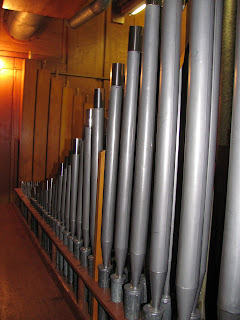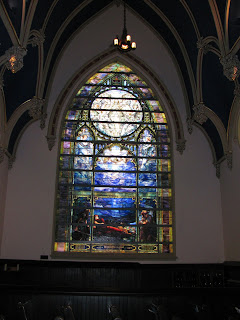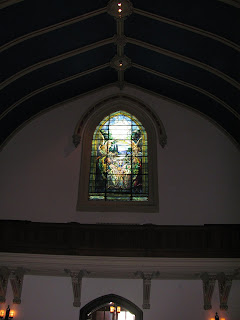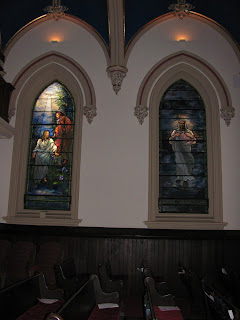 This is the chancel of the church.
This is the chancel of the church. And this is the rear gallery.
And this is the rear gallery. The front organ cases feature the names of composers on the casework.
The front organ cases feature the names of composers on the casework. Beautiful flowers were already in place for the services on Sunday.
Beautiful flowers were already in place for the services on Sunday. The cases are identical, except for the console on the left side. The large pipes are painted; the smaller pipes are polished tin.
The cases are identical, except for the console on the left side. The large pipes are painted; the smaller pipes are polished tin. Console; the mirror can be concealed by pulling down a panel. The left stops are Gallery Pedal, Main Pedal, and Swell. The right stops are Great, Positiv and Gallery. The drawer on the right contains controls for the combination action.
Console; the mirror can be concealed by pulling down a panel. The left stops are Gallery Pedal, Main Pedal, and Swell. The right stops are Great, Positiv and Gallery. The drawer on the right contains controls for the combination action. Closer view of the console. The Great, Swell and Positiv are in the case with the console; the Pedal is opposite. The Gallery organ is in two cases on either side of a window.
Closer view of the console. The Great, Swell and Positiv are in the case with the console; the Pedal is opposite. The Gallery organ is in two cases on either side of a window. First to try the organ was our SubDean, Clarice Snyder.
First to try the organ was our SubDean, Clarice Snyder. Next up was Emily Koons.
Next up was Emily Koons. Then our Dean, John Brooks.
Then our Dean, John Brooks. Then past Dean Peter Crisafulli.
Then past Dean Peter Crisafulli. Two manual console in the gallery.
Two manual console in the gallery. The pistons above the upper manual are the General pistons of the main organ, so that you can play the main organ from the Gallery organ. On the main console the Gallery division is floating; here it is divided into two manuals and pedal.
The pistons above the upper manual are the General pistons of the main organ, so that you can play the main organ from the Gallery organ. On the main console the Gallery division is floating; here it is divided into two manuals and pedal. View of the chancel from the gallery.
View of the chancel from the gallery. The hooded Tromba inside the right gallery case. When this was being played against the front organ, standing in the gallery, it sounded like the Tromba was ahead of the main organ. The two are just that far apart.
The hooded Tromba inside the right gallery case. When this was being played against the front organ, standing in the gallery, it sounded like the Tromba was ahead of the main organ. The two are just that far apart. Peter Crisafulli trying the gallery organ. We found many beautiful sounds in this division, which we admired more than the front organ.
Peter Crisafulli trying the gallery organ. We found many beautiful sounds in this division, which we admired more than the front organ. The church has many beautiful windows.
The church has many beautiful windows. We also found a four rank Kilgen organ in the chapel on our way out.
We also found a four rank Kilgen organ in the chapel on our way out.From Christ Lutheran we were blown to the inner harbor by the strong winds that day, and we had a delightful lunch at Phillips Seafood Restaurant.
Our second stop of the day was the historic Basilica of the Assumption, America's First Cathedral.
 Clarice Snyder and David McCahan are admiring the Basilica. The red and yellow umbrella on the right is the Papal Umbrella, from the visit of Pope John Paul II in 1995.
Clarice Snyder and David McCahan are admiring the Basilica. The red and yellow umbrella on the right is the Papal Umbrella, from the visit of Pope John Paul II in 1995.
 The organ case in the left transept. The center section is the original casework from the Hall organ of 1819. When the organ was enlarged by Roosevelt in 1884, the case was widened to be the full width of the gallery. When the organ was renovated by Schantz in 1989, they painted the Roosevelt pipes on the side flats brown, to make them disappear, so that the original profile of the Hall organ stands out, making it again the proper scale for the gallery, while maintaining the space necessary for the organ. Peter Crisafulli is playing, and Bill Daly is beside him. Bill is past Dean of the Central Missouri Chapter.
The organ case in the left transept. The center section is the original casework from the Hall organ of 1819. When the organ was enlarged by Roosevelt in 1884, the case was widened to be the full width of the gallery. When the organ was renovated by Schantz in 1989, they painted the Roosevelt pipes on the side flats brown, to make them disappear, so that the original profile of the Hall organ stands out, making it again the proper scale for the gallery, while maintaining the space necessary for the organ. Peter Crisafulli is playing, and Bill Daly is beside him. Bill is past Dean of the Central Missouri Chapter.
 The main altar. The building was designed by Benjamin Henry Latrobe, the architect of the US Capitol. When completed in 1821, the two buildings were of similar size.
The main altar. The building was designed by Benjamin Henry Latrobe, the architect of the US Capitol. When completed in 1821, the two buildings were of similar size.
 Closeup of the carvings of the Hall case, which are very elegant.
Closeup of the carvings of the Hall case, which are very elegant.
 View across to the opposite right transept, which has a slave gallery above. The rear gallery also has a slave gallery.
View across to the opposite right transept, which has a slave gallery above. The rear gallery also has a slave gallery.
 The dome with skylight; originally the windows and skylights were the lights.
The dome with skylight; originally the windows and skylights were the lights.
 Schantz console from 1989, built to resemble an old style of console, but with every modern convenience.
Schantz console from 1989, built to resemble an old style of console, but with every modern convenience.
 Carolyn Booth is playing, while Judy Daffer and Peter Crisafulli look on.
Carolyn Booth is playing, while Judy Daffer and Peter Crisafulli look on.
 Dave McCahan thought it was interesting to have an EXIT sign on the organ case; there is an emergency exit route down what was the original stairway to the gallery. Present day organists can use the elevator. The Roosevelt pipes that have been painted brown are visible in this picture, too.
Dave McCahan thought it was interesting to have an EXIT sign on the organ case; there is an emergency exit route down what was the original stairway to the gallery. Present day organists can use the elevator. The Roosevelt pipes that have been painted brown are visible in this picture, too.
 Another view of the carvings on the Hall case.
Another view of the carvings on the Hall case.
 This view from the organ loft shows the Bishop's Cathedra or chair, with canopy above, the main altar and the pulpit with canopy. With all that marble, the acoustics are incredible.
This view from the organ loft shows the Bishop's Cathedra or chair, with canopy above, the main altar and the pulpit with canopy. With all that marble, the acoustics are incredible.
 Next John Brooks played.
Next John Brooks played.
 Clarice Snyder and David McCahan are admiring the Basilica. The red and yellow umbrella on the right is the Papal Umbrella, from the visit of Pope John Paul II in 1995.
Clarice Snyder and David McCahan are admiring the Basilica. The red and yellow umbrella on the right is the Papal Umbrella, from the visit of Pope John Paul II in 1995. The organ case in the left transept. The center section is the original casework from the Hall organ of 1819. When the organ was enlarged by Roosevelt in 1884, the case was widened to be the full width of the gallery. When the organ was renovated by Schantz in 1989, they painted the Roosevelt pipes on the side flats brown, to make them disappear, so that the original profile of the Hall organ stands out, making it again the proper scale for the gallery, while maintaining the space necessary for the organ. Peter Crisafulli is playing, and Bill Daly is beside him. Bill is past Dean of the Central Missouri Chapter.
The organ case in the left transept. The center section is the original casework from the Hall organ of 1819. When the organ was enlarged by Roosevelt in 1884, the case was widened to be the full width of the gallery. When the organ was renovated by Schantz in 1989, they painted the Roosevelt pipes on the side flats brown, to make them disappear, so that the original profile of the Hall organ stands out, making it again the proper scale for the gallery, while maintaining the space necessary for the organ. Peter Crisafulli is playing, and Bill Daly is beside him. Bill is past Dean of the Central Missouri Chapter. The main altar. The building was designed by Benjamin Henry Latrobe, the architect of the US Capitol. When completed in 1821, the two buildings were of similar size.
The main altar. The building was designed by Benjamin Henry Latrobe, the architect of the US Capitol. When completed in 1821, the two buildings were of similar size. Closeup of the carvings of the Hall case, which are very elegant.
Closeup of the carvings of the Hall case, which are very elegant. View across to the opposite right transept, which has a slave gallery above. The rear gallery also has a slave gallery.
View across to the opposite right transept, which has a slave gallery above. The rear gallery also has a slave gallery. The dome with skylight; originally the windows and skylights were the lights.
The dome with skylight; originally the windows and skylights were the lights. Schantz console from 1989, built to resemble an old style of console, but with every modern convenience.
Schantz console from 1989, built to resemble an old style of console, but with every modern convenience. Carolyn Booth is playing, while Judy Daffer and Peter Crisafulli look on.
Carolyn Booth is playing, while Judy Daffer and Peter Crisafulli look on. Dave McCahan thought it was interesting to have an EXIT sign on the organ case; there is an emergency exit route down what was the original stairway to the gallery. Present day organists can use the elevator. The Roosevelt pipes that have been painted brown are visible in this picture, too.
Dave McCahan thought it was interesting to have an EXIT sign on the organ case; there is an emergency exit route down what was the original stairway to the gallery. Present day organists can use the elevator. The Roosevelt pipes that have been painted brown are visible in this picture, too. Another view of the carvings on the Hall case.
Another view of the carvings on the Hall case. This view from the organ loft shows the Bishop's Cathedra or chair, with canopy above, the main altar and the pulpit with canopy. With all that marble, the acoustics are incredible.
This view from the organ loft shows the Bishop's Cathedra or chair, with canopy above, the main altar and the pulpit with canopy. With all that marble, the acoustics are incredible.Hall 1819
Roosevelt 1884
Schantz 1989
Schantz 1989
 Next John Brooks played.
Next John Brooks played.Our third and final stop was Brown Memorial Park Avenue Presbyterian Church.
 We were met by Dr. John Walker, Director of Music, who told us a brief history of the church. Then, as Virgil Fox had been organist of this church and had worked out his arrangement of "Come, Sweet Death" on this organ, John played it for us.
We were met by Dr. John Walker, Director of Music, who told us a brief history of the church. Then, as Virgil Fox had been organist of this church and had worked out his arrangement of "Come, Sweet Death" on this organ, John played it for us.
 Then Mike Hart told us the history of the Skinner organ. While having no major tonal changes, the console had been rebuilt several times, so he was quite proud of his restoration work, which returned it to the original appearance, but with all the necessary modern controls, as well as removal of previous damages.
Then Mike Hart told us the history of the Skinner organ. While having no major tonal changes, the console had been rebuilt several times, so he was quite proud of his restoration work, which returned it to the original appearance, but with all the necessary modern controls, as well as removal of previous damages.
 First to play was Carolyn Booth.
First to play was Carolyn Booth.
 She was followed by Emily Koons, with Dave McCahan turning pages.
She was followed by Emily Koons, with Dave McCahan turning pages.
 Past Dean Dave Haykin and Dave McCahan looked on while Emily played.
Past Dean Dave Haykin and Dave McCahan looked on while Emily played.
 And here Dave McCahan is also acting as registrant, pulling stops.
And here Dave McCahan is also acting as registrant, pulling stops.
 Then John Brooks played a Tuba Tune.
Then John Brooks played a Tuba Tune.
 Then Mike Hart took us up into the chambers. The Great, Swell & Choir are on the side opposite the console. These are the pipes of the Great division.
Then Mike Hart took us up into the chambers. The Great, Swell & Choir are on the side opposite the console. These are the pipes of the Great division.
 Choir division, with the Clarinet rank in front. To get to the Swell involved climbing a ladder and opening a door and swinging inside, so we declined.
Choir division, with the Clarinet rank in front. To get to the Swell involved climbing a ladder and opening a door and swinging inside, so we declined.
 Looking down on the console from the walk between the chambers.
Looking down on the console from the walk between the chambers.
 The wooden Pedal 16' Open Diapason pipes begin a story below, with their tops up where the tuner can reach them. The facade pipes on both sides are real pipes from a former organ, but they no longer speak.
The wooden Pedal 16' Open Diapason pipes begin a story below, with their tops up where the tuner can reach them. The facade pipes on both sides are real pipes from a former organ, but they no longer speak.
 The pedal Trombone and Bourdon pipes are on the far wall beyond Dave McCahan and Peter Crisafulli.
The pedal Trombone and Bourdon pipes are on the far wall beyond Dave McCahan and Peter Crisafulli.
 We were met by Dr. John Walker, Director of Music, who told us a brief history of the church. Then, as Virgil Fox had been organist of this church and had worked out his arrangement of "Come, Sweet Death" on this organ, John played it for us.
We were met by Dr. John Walker, Director of Music, who told us a brief history of the church. Then, as Virgil Fox had been organist of this church and had worked out his arrangement of "Come, Sweet Death" on this organ, John played it for us. Then Mike Hart told us the history of the Skinner organ. While having no major tonal changes, the console had been rebuilt several times, so he was quite proud of his restoration work, which returned it to the original appearance, but with all the necessary modern controls, as well as removal of previous damages.
Then Mike Hart told us the history of the Skinner organ. While having no major tonal changes, the console had been rebuilt several times, so he was quite proud of his restoration work, which returned it to the original appearance, but with all the necessary modern controls, as well as removal of previous damages. First to play was Carolyn Booth.
First to play was Carolyn Booth. She was followed by Emily Koons, with Dave McCahan turning pages.
She was followed by Emily Koons, with Dave McCahan turning pages. Past Dean Dave Haykin and Dave McCahan looked on while Emily played.
Past Dean Dave Haykin and Dave McCahan looked on while Emily played. And here Dave McCahan is also acting as registrant, pulling stops.
And here Dave McCahan is also acting as registrant, pulling stops. Then John Brooks played a Tuba Tune.
Then John Brooks played a Tuba Tune. Then Mike Hart took us up into the chambers. The Great, Swell & Choir are on the side opposite the console. These are the pipes of the Great division.
Then Mike Hart took us up into the chambers. The Great, Swell & Choir are on the side opposite the console. These are the pipes of the Great division. Choir division, with the Clarinet rank in front. To get to the Swell involved climbing a ladder and opening a door and swinging inside, so we declined.
Choir division, with the Clarinet rank in front. To get to the Swell involved climbing a ladder and opening a door and swinging inside, so we declined. Looking down on the console from the walk between the chambers.
Looking down on the console from the walk between the chambers. The wooden Pedal 16' Open Diapason pipes begin a story below, with their tops up where the tuner can reach them. The facade pipes on both sides are real pipes from a former organ, but they no longer speak.
The wooden Pedal 16' Open Diapason pipes begin a story below, with their tops up where the tuner can reach them. The facade pipes on both sides are real pipes from a former organ, but they no longer speak. The pedal Trombone and Bourdon pipes are on the far wall beyond Dave McCahan and Peter Crisafulli.
The pedal Trombone and Bourdon pipes are on the far wall beyond Dave McCahan and Peter Crisafulli.









